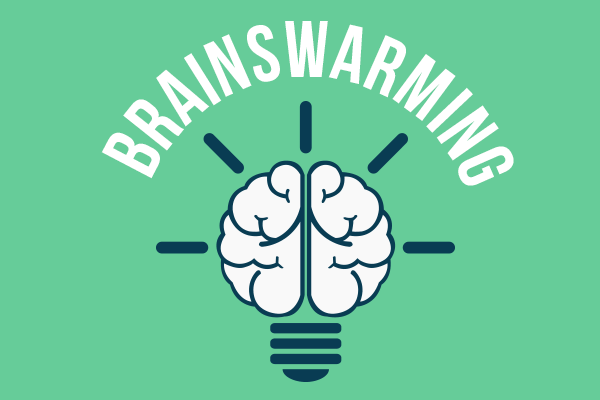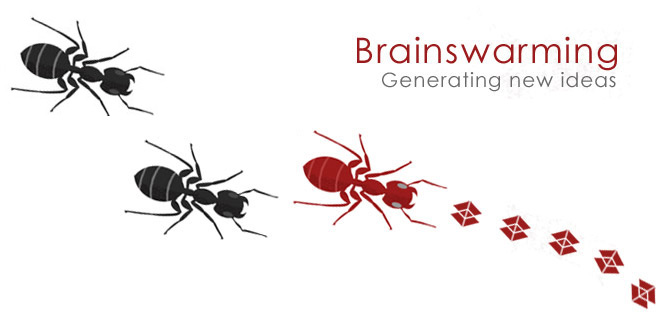Tony McCaffrey focuses on bringing science to the art of innovation. He researches and develops innovation tools at Innovation Accelerator, Inc. With a doctorate in cognitive psychology and a master’s degree in computer science, Tony combines insights from both fields to produce effective tools to enhance both individual and group innovation. BrainSwarming is the latest tool to emerge from his research. He is working to make BrainSwarming into an online platform so remote groups can solve problems from any location.

:: As someone so opinionated about brainstorming, I bet there was an aha moment in which you decided you needed something else. Did you go through something like that to come up with Brainswarming?
Originally, I developed the top-down bottom-up graph to help individuals solve problems. Then, I had an aha moment that the graph might help groups work together. I tried it out with my colleagues. They worked silently on a problem and placed their contributions on a graph. They liked this process much more than brainstorming. I then started reading the research on brainstorming and found that it did not produce more ideas and it did not reliably produce quality ideas. I then started measuring these aspects about my process and discovered that it worked better. Later, I named my process “BrainSwarming” after I read about how swarms of insects solve problems together (i.e., a topic called Swarm Intelligence).
:: For all the people out there happily using brainstorming, what would be your pitch for them to start using brainswarming?
“Ignorance is bliss.” In Spanish, “La ignorancia es felicidad.”If you don’t know there is something better out there, then you are probably happy with what you are using. For example, if you don’t know that cell phones exist, then you just get along by using the phone that sits on your desk.
Try BrainSwarming. You will see that it produces more ideas faster. Also, there is less frustration among the people at the table.
:: Can you explain in a few sentences, what’s brainswarming?
In essence, BrainSwarming is a silent method for generating ideas in groups, in which participants contribute their ideas in short notes on a structured graph.
:: Is brainswarming a replacement of brainstorming or are they complementary?
BrainSwarming is a replacement for brainstorming. Both methods try to help groups generate ideas. BrainSwarming is more effective than brainstorming.
BrainSwarming keeps the good parts of brainstorming and gets rid of the bad. Alex Osborn, the creator of brainstorming, had original goals that were noble. The problem was that the method he created, brainstorming, did not reach those goals very well.
Osborn’s Four Original Goals:
- People can work together: You can combine and build upon each other’s ideas.
- People do not critique each other’s ideas during the session.
- People should go for quantity of ideas.
- People should create unusual, wild ideas.
As described below, BrainSwarming achieves all of Osborn’s goals. Also, BrainSwarming gets rid of the problems that prevent brainstorming from reaching Osborn’s goals.

BrainSwarming Gets Rid of the Bad That Hinders Osborn’s Goals from Being Achieved:
- No more talkative few dominating the session. There is no talking.
- No more critiquing because no one is talking.
- No need for a facilitator to keep people from dominating or critiquing. The Brainswarming process itself keeps people in line because there is no talking.
- No more sharing one at a time. People work in parallel so the work goes much faster.
- No one needs to be a scribe that writes down everything, because everyone is writing and placing their ideas at the correct place on the graph.
- No one needs to interpret and summarize the results because the graph holds all the results–and everyone built it together.
- No one needs to create a summary of the session. Take a picture of the graph and send that out or just keep the graph up on the wall for later use.
- No one needs to read through a textual summary of the session. The graph contains short phrases and places all the ideas in their relationship to each other.
- No one needs to later group the similar ideas together because the grouping is already done as the graph is built.
- No more «wordy» ideas. All contributions are brief as they must fit on a Post-It note.
- No more remembering what people said. It is all visible on the graph.
- No more having your train of thought interrupted. The silence allows you to fluctuate between thinking quietly, writing your ideas, placing them on the master graph, looking at other people’s ideas, and building on other’s ideas.
- No more struggles between top-down (big picture) thinkers and bottom-up (detail oriented) thinkers. The graph integrates both seamlessly.
- No more fear of the boss and colleagues. Silence and anonymous postings on the graph encourages honesty, risk taking, and wildness of ideas.
- No more forcing everyone to be present for the session. The graph remains on the wall so people can contribute at different times. (Online Brainswarming will allow remote groups from around the world to work together.)

:: In my short experience with Brainswarming, I had the feeling it is extremely effective in very specific problems, but I struggle a bit when the problem is more abstract. Is Brainswarming more effective in some particular scenarios? What’s your suggestion when it’s difficult to phrase succinctly a problem in order to use Brainswarming?
I agree that BrainSwarming is very effective when the goal is specific or concrete. I am discovering that an abstract goal indicates that some adjustments need to be made. For example, suppose the goal is to “create an advertisement for a product.” This goal is very general. I have devised a special BrainSwarming method that works very well for creating advertisements. Suppose the goal is to “create a new use for a product.”Again, this goal is very general. I have devised a special BrainSwarming method that works very well for creating new uses for products. In conclusion, problems with abstract goals require variations on the BrainSwarming method. However, the variations are very effective at solving the problems. Much of my current research focuses on creating effective variations for different types of abstract goals.
All the known variations of the BrainSwarming methods are described in the following document. The document describes using BrainSwarming on the following types of problems: technical, strategic planning, marketing, advertising, fundraising, and human resources.
:: For beginners, which are the 3 keys to a successful first Brainswarming exercise?
Here is a link to a free paper on tips for running a BrainSwarming session.
Briefly, three keys would be:
- Focus on contributing to the graph, not solving the whole problem. Don’t try to solve the whole problem at once. Add small pieces. Rephrase the goal in different ways and add each way to the graph. Think of new resources and add them to the graph. Break a resource into its parts and add them to the graph. Later, you can work on connecting together the top network (goal network) and the bottom network (resource network).
- Use just a few words to describe your contribution. If your contribution starts with a verb, then it probably belongs somewhere in the top network (goal network) or in the middle where your resources are interacted together. The goal network contains many verb-phrases that describe the changes you want (e.g., improve sales). The middle part of the graph contains many verb-phrase that describe actions to take (e.g., increase size of sales department, create a better product name). If your contribution begins with a noun (or adjective), then it probably belongs in the bottom network (resource network). Noun-phrases name resources (e.g., internet). Noun-phrases beginning with adjectives name qualities of the resources (e.g., fast wireless connection).
- People have different styles of working. Let each person work according to their own style. Some people will work quietly alone and create many Post-It notes. Then, they will go to the graph and find a place for each of their notes. Other people will write one note at a time and then place that note on the graph. Then, they will look at the graph for a while and get an idea for another contribution that builds upon another person’s idea. Some people like to work top-down by rephrasing the goal. Other people like to work bottom-up by adding new resources and breaking them into parts and features. Some people like to work on parts of the graph where already there are many notes. Other people like to work on parts of the graph that only have a few notes. Let each person work according to their own style.
:: In your experience, is Brainswarming equally effective with different kind of people? I’ve seen how drivers tend to go very rapidly to create solutions rather than explore different branches. Is this something to take into consideration when building team for example? I mean, should the facilitator try to balance teams following some specific guidelines?
The silence of BrainSwarming creates an environment so that introverts and extroverts can work well together. Also, the structure of the graph makes it easy for top-down (i.e., big picture) thinkers and bottom-up (i.e., detail-oriented) thinkers to work well together. With the silence of BrainSwarming, employees feel more comfortable being honest while their bosses are in the room. Further, if the Post-It notes are posted without any names on them (i.e., anonymously), then employees feel even more freedom to be honest when their bosses are in the same room. In this way, bosses and employees can work well together.
Personally, I have never had a problem with drivers. If drivers are part of your group, then they will quickly work vertically to create a solution and will ignore working horizontally to consider diverse possibilities. Without the ability to talk, however, drivers will not be able to stop others from exploring other branches and thinking broadly.

:: I know you’re very adamant on the no speak rule. Isn’t that a step back in collaboration? You could argue that extroverts taking over the activity is a matter of managing extroverts, not killing conversation for good.
There are many reasons why talking is not effective. Extroverts taking control of the group is one of the easier problems to deal with—by having a good facilitator.
Sharing your ideas one at a time is terribly slow and not a good use of time. In contrast, if people write down their ideas at the same time, the work goes much faster. For example, a large company that uses brainstorming bragged that they could generate 100 ideas in an hour. In BrainSwarming, I have reached up to 115 ideas in 15 minutes.
Below are other benefits to using silent writing when compared to talking.
You do not have to remember what everyone else said, because it is all up on the graph for you to look at anytime you want to. No one needs to write down all the ideas, because everyone is writing and placing their ideas at the correct place on the graph. No one needs to create a summary of the session. Take a picture of the graph and send that out or just keep the graph up on the wall for later use.
When most people talk, they tend to use many words. Writing your idea on a Post-It note forces you to be brief. It is like Twitter’s limit of 140 characters. A Post-It note forces you to “self-edit” and get to the core of your idea before sharing it with the group.
When people talk they interrupt each others’ “trains of thought.” With the silence of BrainSwarming, you do not interrupt anyone’s thinking. The silence allows you to fluctuate between thinking quietly, writing your ideas, placing them on the graph, looking at other people’s ideas, and building on other’s ideas.
Many people are afraid to be honest in front of their boss. Writing your idea down and posting it anonymously (i.e., without including your name) encourages honesty, risk taking, and wildness of ideas.
If people talk, then everyone has to be at the meeting to listen. In BrainSwarming, the graph remains on the wall so people can contribute at different times. (Online Brainswarming will allow remote groups from around the world to work together.)
:: Once you have all the ideas on the graph, and you move to a next phase to evaluate them, you need to go back to talking, don’t you? Isn’t then when we can see again some of the issues you describe as for why you shouldn’t talk in the first place?
Talking definitely hurts the idea generation phase. But talking seems necessary for the evaluation and decision phases. I have tried several things. First, I have had people form small groups around their favorite ideas. Each small group can either refine more the idea of their choice or they can begin to analyze it. How much does it cost? What are its advantages and disadvantages? Second, I have had people vote for their favorite ideas. Each person is given three small Post-It notes and they silently vote by placing them next to their favorite ideas. Someone might like an idea so much that they place all of their small Post-It notes next to a single idea. After the voting, then people starting analyzing the ideas based on their advantages and disadvantages. Perhaps, only a few members of the group will perform the analysis. Perhaps, the entire group gathers together to analyze and discuss the ideas. The method you use is up to your group.
In sum, talking is bad for idea generation but it seems to be necessary for evaluation and decision making. When talking resumes, some of the same issues around group dynamics will arise again. Presently, I do not see an alternative to talking during evaluation and decision making. But I am open to hearing ideas on this topic.
:: I know you’re working on some online tools. From my experience, I think brainswarming has a lot of potential on remote collaboration. Can you tell us a bit about your plans for those online tools? What to expect?
Imagine a manager at a global company posting a new BrainSwarming graph online before going to bed. The manager simply places the goal at the top of the graph and a few known resources at the bottom. This manager then sends out invitations to co-workers that a new problem is online and everyone can work on it for the next 48 hours. The manager goes to bed and wakes up the next morning to find many ideas that were added to the graph by colleagues in London, Paris, and Mumbai. The graph keeps all ideas organized. All the contributions are short, 140 characters or less (like Twitter) so that there is not much to read. Contributions to the graph are happening at the same time, so you can see the graph grow in real time.
Now, just look for the places that the top network (the goal network) is connected to the bottom network (the resource network) to see potential, innovative solutions to the original problem.
The manager will like this next point. Later, the manager can get statistics on how many times each co-worker contributed to the graph, whether any of those contributions became part of a solution, and whether any of those contributions were part of the solutions that was ultimately selected as the best one. In this way, managers can measure the problem solving abilities of co-workers using objective metrics.
:: You’ve published some materials under Creative Commons, yet you do have a business around Brainswarming. How do you expect people to use Brainswarming?
We have different business models for the manual process and the online version.
Manual BrainSwarming:
By “manual,” I mean the process that people engage in around a conference table.
People can do the process on their own for free. When I facilitate a BrainSwarming session, I use some advanced techniques to do two things: (1) help the team uncover what it is overlooking and (2) help the team find “similar” problems that have already been solved.
I would be paid as a consultant to help a group do a BrainSwarming session using these advanced techniques. Also, I would be paid to train people how to do these advanced techniques on their own.
Online BrainSwarming:
Online BrainSwarming is a software platform that allows people to solve problems together from different locations. People will be able to build a BrainSwarming graph together online.
We are thinking of having two versions of Online Brainswarming. The first version would be a basic, free version for Open Innovation. The second version would include software that would automatically perform the advanced techniques. Companies would pay to use the second version. The software would continuously make suggestions that would help the team uncover what it is overlooking. The software would also search for problems “similar” to the current problem and look for solutions that the team may not know about.
:: I think that feature of suggesting similar problems to the one you’re working on is something very powerful and cool. Can you explain a bit more how that works?
Innovation requires a non-Google way to search. Innovation requires looking into the future and Google only finds things from the past. I have created a way of searching that gives you a peek into the future by searching sideways (i.e., laterally). Let me explain using an example.
A big problem in American football is concussions. A Google search on “ways to reduce concussions” returns all the known approaches for addressing this problem. But we wanted to find a new approach that has never been tried before. So, we used my search engine that searches laterally. We typed “reduce concussions” into my lateral search engine and it created over two dozen related search strings, including the following: reduce energy, minimize force, exchange forces, substitute energy, oppose energy, repel energy, lessen momentum, and alter direction. A search on this group of search strings returned solutions from diverse fields. Quickly, we identified a known solution from a distant field that would work for the concussion problem. Experts have evaluated our solution and we are now seeking a patent.
The key to peeking into the future is to look laterally (i.e., sideways). Searching with Google keeps you confined to one area. Google does not generalize their search strings properly to help people be innovative. With Google, you end up too close to the area you started. A lateral search engine generalizes the search strings in the right way to find many possible solutions to your problem from diverse fields.
:: You’ve just launched a Kickstarter campaign to fund the online version of the software. Can you tell us your goals and why you chose it vs other fundraising activities?
We are receiving many requests for an online version of BrainSwarming so that global teams can problem solve together effectively, visually, and innovatively.
We are pursuing several ways to fund the online version of BrainSwarming. Because of all the interest we are receiving from potential customers, we decided to reach out to them through a Kickstarter campaign. However, a large consulting company has approached us about Online BrainSwarming, so we are talking to them also.
Help Kickstart an Online BrainSwarming Platform into existence so people can solve problems together from all over the world and create innovative solutions. Donate in exchange for use of the Online BrainSwarming. Follow the link to learn more and donate.

